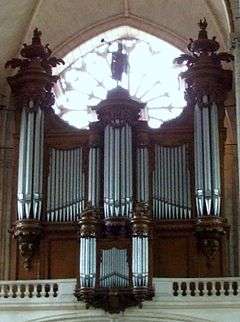Poitiers Cathedral
Poitiers Cathedral (French: Cathédrale Saint-Pierre de Poitiers) is a Roman Catholic church in Poitiers, France. It is the seat of the Archbishop of Poitiers
| Poitiers Cathedral | |
French: Cathédrale Saint-Pierre de Poitiers | |
 Cathedral of St Peter in Poitiers | |
| 46.5803°N 0.3493°E | |
| Country | France |
|---|---|
| Denomination | Roman Catholic |
| History | |
| Status | Cathedral |
| Architecture | |
| Functional status | Active |
| Specifications | |
| Dome height (inner) | 89 feet (27 m) |
| Spire height | 110 feet (34 m) |
| Administration | |
| Diocese | Poitiers |
| Clergy | |
| Archbishop | Pascal Wintzer |

History
Its construction began in 1162 by Henry II of England and Eleanor of Aquitaine on the ruins of a Roman basilica, and work was well advanced by the end of the 12th century. It is the largest medieval monument in the city of Poitiers.
Architecture
It is built in the Romanesque and Early Gothic styles, the latter predominating. It consists of a nave flanked on either side by two aisles. The nave and aisles are almost equal in height and width, all three of which decrease towards the west, thus enhancing the perspective. Its length is 308 feet (94 m), and the keystone of the central vaulted roof is 89 feet (27 m) above the pavement. There is no apse, and the exterior generally has a heavy appearance. The principal front, which is broad relative to its height, has unfinished side-towers 105 feet (32 m) and {convert|110|ft|m}} tall, begun in the 13th century.
Most of the windows of the choir and the transepts preserve their stained glass of the 12th and 13th centuries; the end window, the Crucifixion Window contains the figures of Henry II and Eleanor. It was completed in about 1165, making it one of the earliest stained-glass cathedral windows in France. [1] The choir stalls, carved between 1235 and 1257, are also among the oldest in France.
Organ
On the night of 25 December 1681,← the organ was destroyed by fire. It was not until 1770-78 that a campaign was launched to build a replacement. François-Henri Clicquot, at that time the leading organ-builder in France, was appointed to undertake the work but died on Pentecost 1790 before completing the work. His son, Claude-François Clicquot, finished the job, handing it over for presentation in March 1791. The instrument is a beautiful example of eighteenth-century organ design, and is still largely intact.[2]
References
- Mignon, Olivier, Architecture du Patrimoine Français- Abbayes, Églises, Cathédrales et Châtaeaux, (2017), Éditions Ouest-France, (in French), ISBN 978-2-7373-7611-5, pg. 111,
- Poitiers cathédrale, orgue.
External links
- Cathedral exterior, and external view of one of the numerous churches in Poitiers
- Cathedral interior
- *"Poitiers cathédrale, orgue Clicquot". Orgues & vitraux. Retrieved 2012-11-25.
See also
- List of Gothic Cathedrals in Europe
| Wikimedia Commons has media related to Poitiers Cathedral. |